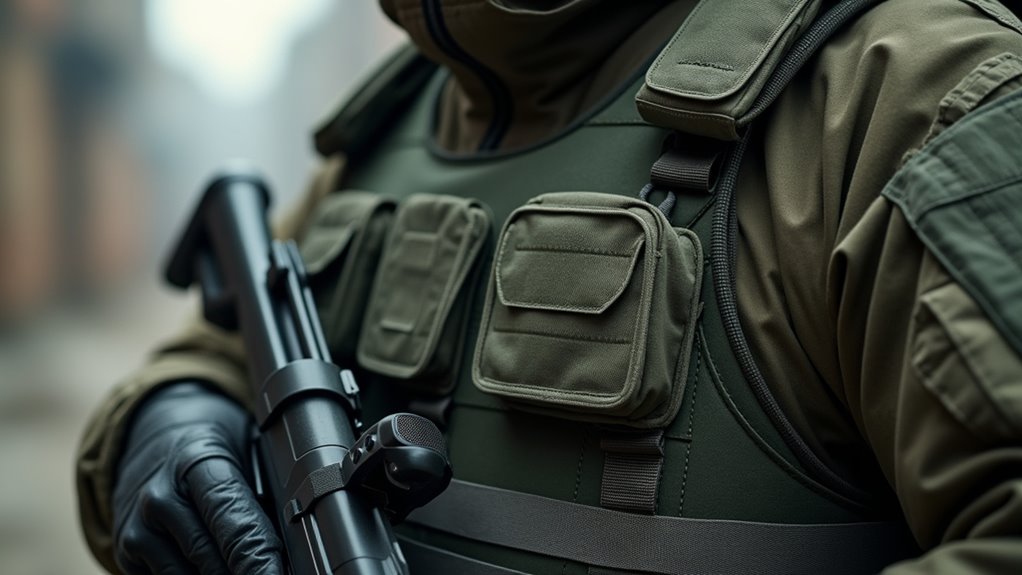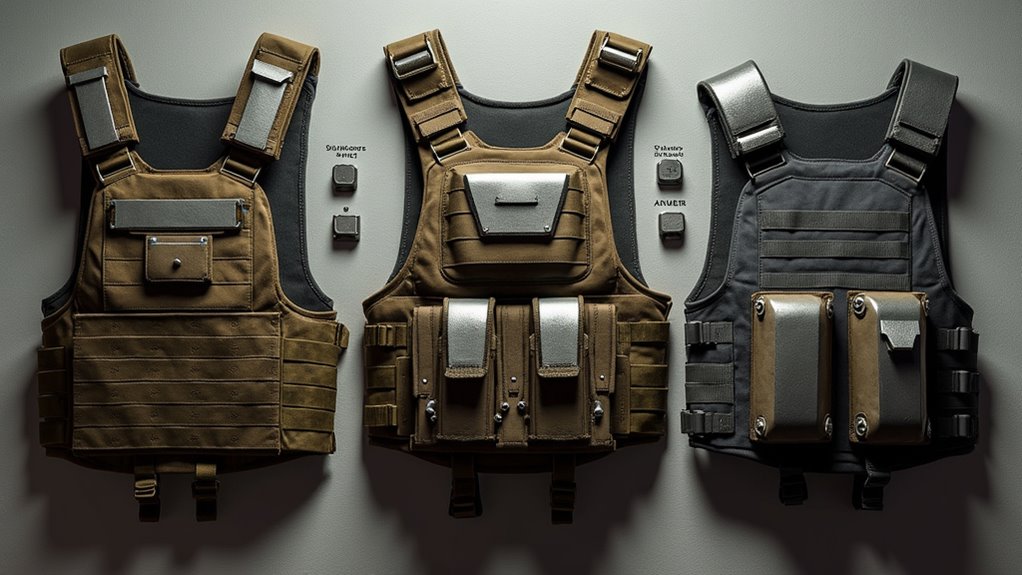Escape From Tarkov Armour Guide Level by Level

Understanding Armor Classes and Their Importance
When you dive into the world of Escape From Tarkov, understanding armor classes and their importance can make all the difference in your survival.
 Armor mechanics play a crucial role in how you absorb damage, and different classes offer varying levels of protection. Higher-class armors can withstand more powerful rounds, giving you valuable tactical advantages in firefights.
Armor mechanics play a crucial role in how you absorb damage, and different classes offer varying levels of protection. Higher-class armors can withstand more powerful rounds, giving you valuable tactical advantages in firefights.
For instance, class 5 and 6 armors provide significant stopping power against most ammunition, allowing you to engage enemies more confidently. Conversely, lower-class armors may not withstand high-caliber rounds, leaving you vulnerable in intense situations.
Additionally, consider weight and mobility; heavier armors can slow you down, affecting your agility and reaction time. Balancing protection with speed is essential for effective gameplay. By mastering armor classes, you’ll enhance your chances of survival and improve your overall performance in Tarkov’s unforgiving environment.
Level 1 Armor: Basics and Best Options
Level 1 armor serves as the entry point for players looking to enhance their survivability in Escape From Tarkov. At this level, you’ll encounter basic armor types like the 6B3TM and Paca, which provide minimal protection but are crucial for early-game encounters. While they won’t stop high-caliber rounds, they can absorb some damage from lower-tier threats.
To maximize your effectiveness, consider essential upgrades. Adding armor plates to your basic armor can improve its damage resistance significantly, allowing you to survive longer in firefights. Additionally, focus on maintaining your armor's durability; even low-tier options can be effective if kept in good condition.
Level 2 Armor: Balancing Protection and Mobility
As you progress in Escape From Tarkov, you'll find that Level 2 armor strikes a crucial balance between protection and mobility. This armor offers better defense against standard calibers while keeping you agile in combat. When choosing Level 2 armor, it’s essential to consider mobility vs protection; while you want to mitigate damage, you also need to maintain your ability to maneuver effectively.
Armor weight considerations play a significant role here. Heavier armor can provide more protection but might slow you down, impacting your stamina and response time. Level 2 armor typically weighs less than higher-tier options, allowing for a more fluid gameplay experience.
You'll want to assess your play style—if you're engaging in close-quarters battles, the speed afforded by Level 2 can be a game-changer. Balancing these factors will enhance your survivability while still enabling you to stay nimble on the battlefield.
Level 3 Armor: Enhanced Defense for Mid-Tier Players
When you're gearing up with Level 3 armor, understanding armor ratings is crucial for maximizing your defense. This tier offers a significant upgrade in protection, making it a solid choice for mid-tier players like you. Let’s explore the best Level 3 options available and how they can enhance your survival chances in Tarkov.
Armor Ratings Explained
Armour ratings play a crucial role in your survival during intense firefights in Escape From Tarkov, especially when considering Level 3 armor. Understanding armor material types and their durability factors can make a significant difference in your gameplay experience.
- You'll feel the adrenaline rush when you survive a burst of gunfire.
- The satisfaction of outsmarting opponents while wearing reliable armor is unparalleled.
- Knowing your armor can absorb damage gives you confidence to engage.
Level 3 armor offers enhanced protection, making it ideal for mid-tier players. Each armor's rating reflects its effectiveness against various ammunition types, so it's essential to choose wisely. Balancing armor weight and protection can lead to better tactical decisions in the heat of battle.
Best Level 3 Choices
Choosing the right Level 3 armor can significantly enhance your defense without weighing you down too much. When it comes to the best Level 3 choices, the 6B3TM-01 and the PACA are excellent options. The 6B3TM-01 offers solid armor durability against both bullets and shrapnel, allowing you to face tougher opponents with confidence. On the other hand, the PACA is lightweight, providing decent protection while keeping your mobility intact.
Both of these armors strike a balance between weight and defense, making them ideal for mid-tier players. Remember, when selecting your armor, consider not just the protection level, but also how it fits into your overall loadout. A well-rounded choice can really make a difference in your survival rate.
Level 4 Armor: Top Choices for Experienced Survivors
While navigating the treacherous landscapes of Tarkov, having the right protection can be the difference between life and death. Level 4 armor is essential for experienced survivors who want to mitigate the risks of high armor penetration ammunition. This tier offers you significant tactical advantages, allowing you to withstand rounds from powerful weapons that would easily pierce lower-level gear.
Consider these top choices for your loadout:
- Fort Defender 2: Exceptional durability with a solid weight-to-protection ratio.
- Zhuk-3: A great balance of mobility and armor, perfect for aggressive play.
- 6B13: Offers high protection and covers vital areas effectively.
With these options, you’ll enhance your survivability and maintain an edge in firefights, ensuring you can engage effectively without compromising your safety. Choose wisely, and make every bullet count!
Special Armor Sets: Unique Benefits and Considerations
When it comes to enhancing your tactical options in Escape From Tarkov, special armor sets can provide unique benefits that go beyond standard protection. These specialized designs, like the Ghillie suit or the Kiver helmet, often include features that grant tactical advantages, such as camouflage or increased visibility for your peripheral vision.
Choosing the right special armor can significantly affect your gameplay, especially in high-stakes encounters. For instance, the 6B43 armor offers excellent protection while maintaining mobility, allowing you to maneuver effectively. However, some sets may come with trade-offs, like weight or limited protection against specific ammunition types.
It's crucial to assess your playstyle and the scenarios you expect to face. By understanding the unique benefits and considerations of each special armor set, you can better equip yourself for survival and success in Tarkov's unforgiving environment.
Frequently Asked Questions
How Does Armor Durability Affect Gameplay in Tarkov?
Armor durability significantly affects gameplay in Tarkov. It impacts armor effectiveness, meaning damaged gear offers less protection. You’ll need to strategize around your armor's condition to maintain tactical advantages during intense firefights and encounters.
Can Armor Be Repaired, and if So, How?
Yes, armor can be repaired using armor repair methods like the mechanic or workbench. However, keep in mind the armor repair costs, which can vary depending on the type and level of damage sustained.
What Are the Best Armor-Piercing Ammunition Types?
For optimal ammo selection, consider using 7.62x51mm M61 or 5.45x39mm BS rounds. Understanding armor penetration mechanics helps you exploit enemy weaknesses, ensuring effective engagement. Choose wisely to maximize your combat effectiveness in challenging encounters.
How Do Different Armor Materials Impact Weight?
Different armor materials significantly impact weight; lighter materials like Kevlar enhance mobility, while heavier options like steel offer better protection but slow you down. Balancing armor weight and material types is crucial for tactical efficiency.
Are There Any Hidden Stats for Armor Worth Knowing?
Yes, armor has hidden stats affecting its effectiveness. You'll find that certain materials offer varying levels of damage reduction against specific ammunition types, impacting your survivability. Knowing these can significantly enhance your tactical decisions in combat.
